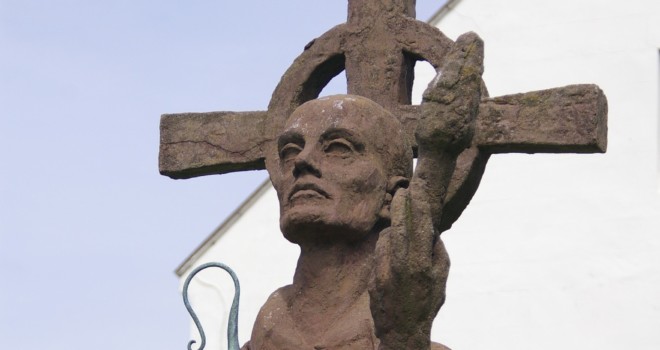
 On this day in 651 AD, St. Aidan of Lindisfarne, among the greatest missionaries of the early medieval period, died while on one of his frequent preaching missions in Northern England. However, as with many great saints, St. Aidan’s legacy continues to live on. For from his monastery on Lindisfarne the light of Christ would permeate Great Britain and much of Europe.
On this day in 651 AD, St. Aidan of Lindisfarne, among the greatest missionaries of the early medieval period, died while on one of his frequent preaching missions in Northern England. However, as with many great saints, St. Aidan’s legacy continues to live on. For from his monastery on Lindisfarne the light of Christ would permeate Great Britain and much of Europe.
For all his great influence, we actually know very little about this early Apostle to the Britons. What we do know largely comes from the Venerable Bede in his unmatched Ecclesiastical History of the English People.
To celebrate his feast day, and to call for his intercession when we need many more missionaries with his zeal, here are a five things you should know about St. Aidan of Lindisfarne.
1. Called By a Saintly King
St. Aidan began his life of service on the Isle of Iona, just off the coast of Scotland. The monastery at Iona was established by Irish monks under St. Columba, another great Celtic missionary during the so-called “dark ages.” About a century later, in St. Aidan’s time, the monastery had become a major center of Gaelic Christianity and was receiving and sending monks across Europe.
By this time, Christianity in Northern England was largely replaced by the paganism of both native Britons and the Anglo-Saxon conquerors. The Kingdom of Northumbria (northern England and south-east Scotland) had just been reconquered by King St. Oswald of Northumbria. Oswald took back his father’s throne at the Battle of Heavenfield, where he prepared by praying before a wooden cross, and possibly a relic of the True Cross. Next, Oswald beheld a vision of St. Columba who promised victory if his generals would be baptized. At council, all agreed to be baptized the night before and victory came to Oswald.
Oswald’s Northumbrian kingdom was small but remarkably diverse. One could hear at least four languages within the kingdom’s borders and there was a mix of church ruins and pagan sites dotting the landscape. While Christianity was initially brought to Britain by Roman saints, and strengthened by Sts. Gregory and Augustine of Canterbury, it had fallen away from the Britons with the Anglo-Saxon invasions.
Meanwhile, Ireland had been converted by St. Patrick and then the Scots and Picts were converted by St. Columba. Among the Kingdoms of Ireland and Scotland, Christianity had established great monasteries, libraries, and schools and it was now their time to bring Christianity back to England.
It was in this context that St. Oswald wished to make his kingdom Christian again. Thus, the victorious king asked the monks of St. Columba’s Iona to send him a missionary to be an Apostle to Northumbria.
2. He Wasn’t the First Missionary to Northumbria
Sometimes, missions don’t work out. In the case of Northumbria, the Abbott of Iona responded to Oswald’s request by sending a monk who was known to be harsh and severe. He had some trouble with the languages and he found that the people refused to listen to him. He made no progress in converting people and returned to Iona, reporting that the people of Iona were too barbarous and stubborn to be reached.
St. Aidan heard this discouraging report and rose to chastise a bishop and brother monk. Aidan ended his remarks by saying,
“You should have followed the practice of the Apostles, and begun by giving them the milk of simpler teaching, and gradually nourished them with the word of God until they were capable of greater perfection and able to follow the loftier precepts of Christ.”
St. Aidan was known to have the grace of discretion, and he was showing it here with his insight into preaching. If the people had forgotten Christ, they would need loving patience and instruction. Upon hearing these words, the Abbot knew that he found their next missionary.
3. The Asceticism of St. Aidan of Lindisfarne
According to Bede, St. Aidan’s “course of life was so different from the slothfulness of our times.” When you consider that Bede was an 8th century monk, we can begin to imagine the great monastic discipline of Aidan. Even before he left for England, St. Aidan was well-known for both his ascetic practices but also his great gentleness. His gentle example actually encouraged his fellow monks to extend their fasts on Wednesdays and Friday and to spend more time in prayer and learning.
For his new monastery and diocese, St. Aidan chose the rocky island of Lindisfarne which greatly appealed to his sensibilities. The island is cut off from the mainland at high tide but pilgrims can walk the causeway at high tide. Even today, the holy island feels remote.
Any wealth that was given to St. Aidan was almost immediately given to the poor or used to free slaves. Some of these slaves followed Aidan back to Lindisfarne and were educated by him, and a few even became priests.
Feeling that a horse might be too decadent, Aidan preferred to walk. He was known for conversing with anyone he encountered on the road, whether they were a peasant or a noble. From these trips he had converted and baptized countless people and earned more monks for his missions. Soon, he had established (or re-established) parishes all over Northern England.
4. Patron Saint of Firefighters
Along with St. Florian, Aidan of Lindisfarne is the patron saint of firefighters. You’re not alone if that surprises you, but there is a story behind this.
St. Aidan was praying in his monastery when a pagan army attacked the royal town of Bamburgh. The invaders piled up on the walls, which the invaders set ablaze. St. Aidan saw the fire and could smell the smoke from Lindisfarne. At once, St. Aidan began to pray for the town and all who dwelt inside.
The cries of St. Aidan were heard for the wind abruptly changed and sent the flames and smoke towards the invaders. By the prayers of St. Aidan, Bamburgh and the royal house was saved from destruction. This not only makes him a patron of Northumbria, but also of firefighters. With wildfires raging everywhere, St. Aidan is a patron we can call upon to protect the firefighters who are risking their lives.
5. An Incorruptible Hand
St. Aidan’s fame spread far and wide due to his humility, kindness, and the great number of miracles that he brought about. King Oswald thus invited St. Aidan to his castle for various feasts, although the bishop rarely attended and then would only eat in silence before returning to his prayers. On one particular Easter feast, Aidan got to observe the effect he had on the king.
As a silver platter full of rich foods was placed on their table, a servant entered the dining hall to inform the king and bishop of a multitude begging for alms outside the gates. Before Aidan could speak, Oswald immediately ordered all the food to be distributed to the beggars and for the silver plates to be broken into pieces and given to them. Seeing such an act of generosity, Aidan grasped the king’s right hand and blessed him, saying, “May this hand never decay.” And it never did.
Bede records that even after Oswald was struck down in battle his right arm never corrupted and was kept in a shrine where many people reported miraculous cures from the king’s relics.

From The Lindisfarne Gospels.
St. Aidan of Lindisfarne, Pray for Us!
A loving bishop with a missionary zeal can seem a rare thing these days. St. Aidan of Lindisfarne shows us that such a bishop can change history. From his rocky monastery, missionaries would travel throughout Britain and parts of Europe with the same missionary zeal of their founder. Along with numerous parishes and monasteries, the monks of Lindisfarne also gave us The Lindisfarne Gospels, an illuminated manuscript and medieval treasure.
On his feast day, and every day, we can turn to St. Aidan in prayer for a renewal of our Church and in hopes that God can send us another missionary saint.
image: lindsayascott / Pixabay











